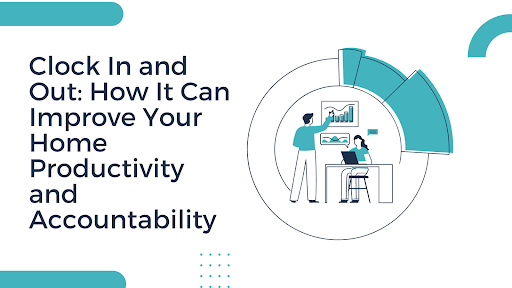
With 42% of the U.S. labor force now working from home full-time, it’s becoming increasingly important to find ways to stay productive and accountable while working from home. One simple but highly effective strategy is tracking your work hours each day.
The Importance of Clocking In and Out at Home
When you work in an office, it’s easy to differentiate between work time and personal time. Your arrival to the office signals the start of your workday and leaving the office signifies its end. But without that physical separation, our work and personal lives can easily blend together when working from home.
Clocking in and out establishes a ritual that indicates the start and finish of your workday. This provides much-needed structure and routine when working from home. Having set work hours can enhance your productivity by minimizing distractions and irrelevant tasks during your designated work time. Make sure to clock in and clock out on time.
How Clocking In and Out Enhances Productivity
Numerous studies have shown that employees who work from home are on average 13% more productive than their office fellows. But in order to get these productivity benefits, it is important to manage your time effectively.
Clocking in and out does just that by tracking your work hours and providing data about your most and least productive times of day. You can then use this information to identify opportunities for improvement. For example, you may discover you achieve the most work in the mornings and do better with shorter but more frequent breaks throughout the day. Making improvements based on your own productivity patterns can enhance your efficiency.
Effective time tracking will also identify your biggest distractions. Whether it’s household noises, appointments or suspending activities like social media, knowing where you spend your time allows you to minimize distractions during work hours. This leads to better focus and concentration, enabling you to get more done in less time.
Accountability through Time Tracking
When employees track their time, they are less likely to over-report hours worked. This promotes accountability in ensuring accurate time sheets. For remote employees, being accountable for how time is spent also motivates better compliance to fixed work hours.
Automated time tracking tools can streamline this process by reducing the time it takes to calculate time cards from 7 minutes per card per pay period to just 1 minute. This allows more time spent productively working versus manually tracking hours.
Accountability for accurate timekeeping results in paychecks and invoices being delivered on schedule. In fact, 93% of employees in the U.S. report that their paychecks are consistently on time thanks to time tracking. When you can rely on regular payment for your work, it reduces financial concerns and provides motivation to maintain productivity.
Tools and Techniques for Effective Time Tracking
Fortunately, there are now more tools than ever to track time easily:
Project Management Tools
Project Management tools like Asana, Trello, and Basecamp allow you to monitor time at the task level to have greater clarity into where your time goes.
Time Tracking Apps
Time Tracking applications like Toggl, Harvest, and TSheets offer convenient ways to start and stop timers or clock in and out of work shifts. Most sync across devices.
Calendar Apps
Calendar apps like Google Calendar, Outlook, and Phone Calendar let you schedule work hours and appointments easily. This makes it easy to stick to your designated work times.
Browser Extensions
The browser comes with a number of tracking extensions. For example, Chrome extensions like RescueTime, Hours, and Clockify integrate time tracking directly into your Chrome browser for easy access.
Pixelpoint
Apps like Pixelpoint take screenshots of your desktop at regular intervals to reveal how you spend time on your computer. It helps you to track your work easily.
When choosing a time tracking tool, consider ease of use and integration with other tools you rely on. The best techniques are those you’ll actually use consistently.
Overcoming Challenges in Time Tracking
Adopting new habits presents challenges, and time tracking is no exception. Here are some common obstacles and how to overcome them:
Forgetting to Start and Stop Timers
Build the practice of clocking in and out into your daily routine. Do it as soon as you sit down to work and before you leave your desk for the day. Forgetting to start and stop timers can cause you to miscalculate your working hours.
Tools Disrupt Workflow
Look for time tracking tools that operate seamlessly in the background without interrupting your work. Browser extensions can be ideal for this.
Measuring Progress by Time
Focus instead on completing projects and deep work. The hours will take care of themselves. Measuring progress over time can lead to a lack of motivation.
Obsessing Over Metrics
Having short objectives can help your work more productively. Review your time data periodically rather than daily. Use it to identify patterns and opportunities rather than criticizing how you spend each minute.
With consistent practice, clocking in and out will soon become second nature. And you’ll start to reap the many benefits in terms of productivity, accountability, and more.

Source: Business News Daily
Frequently Asked Questions
- How can I remember to clock in and out when working from home?
Make it part of your daily rituals before and after work. Keep your time tracker open and visible as a reminder. Schedule clock-in and out times on your calendar. Set phone alerts to prompt you.
- What tools are recommended for tracking time at home?
Apps like Toggl, Harvest, and TSheets are popular for automatic time tracking. Chrome extensions like RescueTime are handy for passive tracking while you work. Choose tools that integrate smoothly into your workflow.
- How can I ensure I’m not overworking myself when clocking in and out?
Use time-tracking data to set realistic goals and schedules. Take regular breaks during the day and disconnect at the end of work hours. Set up alerts if you go over your scheduled hours. Most importantly, don’t be too hard on yourself – progress takes time
Conclusion
Clocking in and out is a simple yet powerful way to build more productivity and accountability into your day when working from home. By providing structure, enhancing focus, and promoting responsible time management, this practice can help remote employees thrive.
The key is choosing time-tracking solutions that seamlessly integrate into your workflow while providing valuable visibility into your work habits. With consistent use, clocking in and out will become a healthy habit that pays dividends.
The work-from-home revolution is here to stay. Adopting small but impactful changes like clocking in and out allows remote teams to succeed over the long term.
- Productivity in business
- Productivity in management





